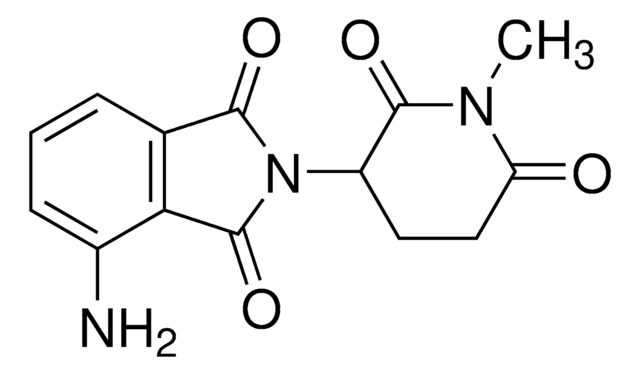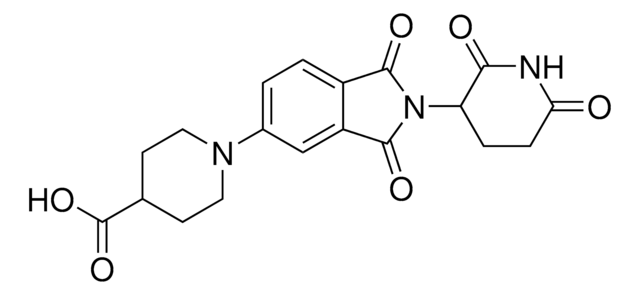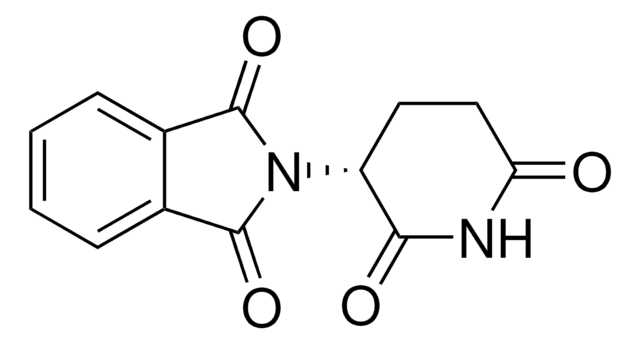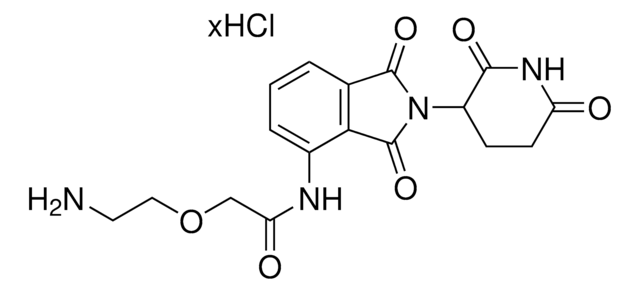901558
Lenalidomide
≥95%
Synonyme(s) :
1-Oxo-4-amino-2-(2,6-dioxopiperidin-3-yl)isoindole, 3-(4-Amino-1,3-dihydro-1-oxo-2H-isoindol-2-yl)-2,6-piperidinedione, 3-(4-Amino-1-oxoisoindolin-2-yl)piperidine-2,6-dione, E3 Ligase ligand, Ligand for PROTAC® research
About This Item
Produits recommandés
ligand
lenalidomide
Pureté
≥95%
Forme
powder
Pertinence de la réaction
reagent type: ligand
Pf
265-268 °C
Température de stockage
2-8°C
Chaîne SMILES
O=C1N(C2CCC(NC2=O)=O)CC3=C1C=CC=C3N
InChI
1S/C13H13N3O3/c14-9-3-1-2-7-8(9)6-16(13(7)19)10-4-5-11(17)15-12(10)18/h1-3,10H,4-6,14H2,(H,15,17,18)
Clé InChI
GOTYRUGSSMKFNF-UHFFFAOYSA-N
Vous recherchez des produits similaires ? Visite Guide de comparaison des produits
Application
.
Autres remarques
Portal: Building PROTAC® Degraders for Targeted Protein Degradation
Structure of the human Cereblon–DDB1–lenalidomide complex reveals basis for responsiveness to thalidomide analogs
Lenalidomide causes selective degradation of IKZF1 and IKZF3 in multiple myeloma cells
The myeloma drug lenalidomide promotes the cereblon-dependent destruction of Ikaros proteins
Informations légales
Produit(s) apparenté(s)
Mention d'avertissement
Danger
Mentions de danger
Conseils de prudence
Classification des risques
Repr. 1B - STOT RE 2
Organes cibles
Blood
Code de la classe de stockage
6.1C - Combustible acute toxic Cat.3 / toxic compounds or compounds which causing chronic effects
Classe de danger pour l'eau (WGK)
WGK 3
Point d'éclair (°F)
Not applicable
Point d'éclair (°C)
Not applicable
Certificats d'analyse (COA)
Recherchez un Certificats d'analyse (COA) en saisissant le numéro de lot du produit. Les numéros de lot figurent sur l'étiquette du produit après les mots "Lot" ou "Batch".
Déjà en possession de ce produit ?
Retrouvez la documentation relative aux produits que vous avez récemment achetés dans la Bibliothèque de documents.
Les clients ont également consulté
Articles
Protein Degrader Building Blocks are a collection of crosslinker-E3 ligand conjugates with a pendant functional group for covalent linkage to a target ligand.
Notre équipe de scientifiques dispose d'une expérience dans tous les secteurs de la recherche, notamment en sciences de la vie, science des matériaux, synthèse chimique, chromatographie, analyse et dans de nombreux autres domaines..
Contacter notre Service technique
















